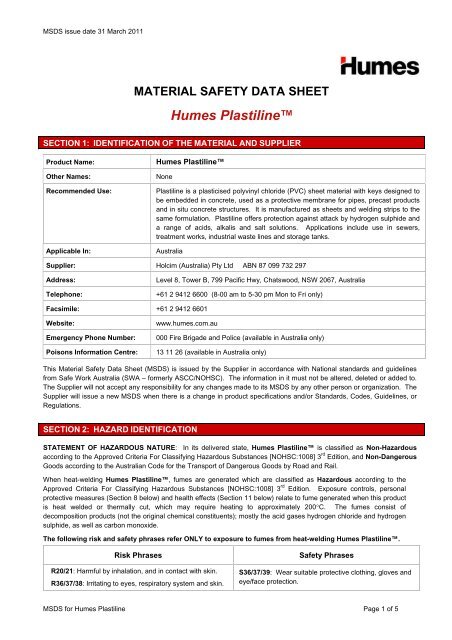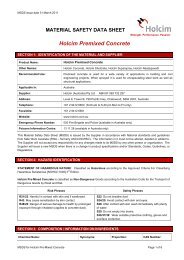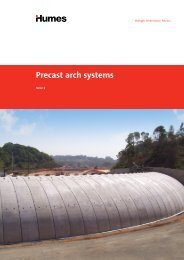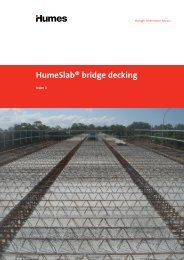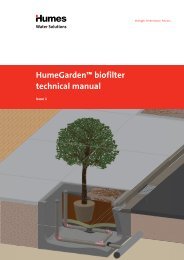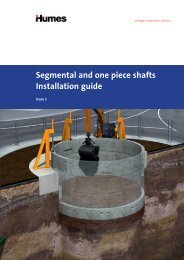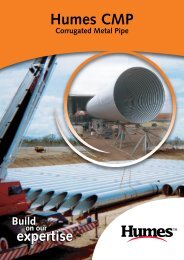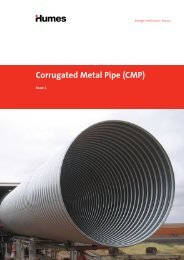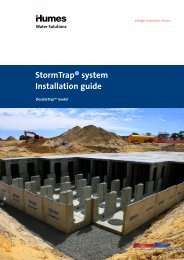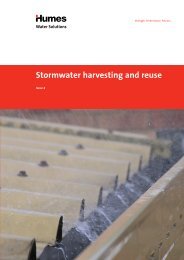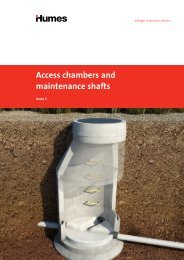Plastiline® MSDS - Humes
Plastiline® MSDS - Humes
Plastiline® MSDS - Humes
You also want an ePaper? Increase the reach of your titles
YUMPU automatically turns print PDFs into web optimized ePapers that Google loves.
<strong>MSDS</strong> issue date 31 March 2011MATERIAL SAFETY DATA SHEET<strong>Humes</strong> PlastilineSECTION 1: IDENTIFICATION OF THE MATERIAL AND SUPPLIERProduct Name:Other Names:Recommended Use:Applicable In:<strong>Humes</strong> PlastilineNonePlastiline is a plasticised polyvinyl chloride (PVC) sheet material with keys designed tobe embedded in concrete, used as a protective membrane for pipes, precast productsand in situ concrete structures. It is manufactured as sheets and welding strips to thesame formulation. Plastiline offers protection against attack by hydrogen sulphide anda range of acids, alkalis and salt solutions. Applications include use in sewers,treatment works, industrial waste lines and storage tanks.AustraliaSupplier: Holcim (Australia) Pty Ltd ABN 87 099 732 297Address:Telephone:Level 8, Tower B, 799 Pacific Hwy, Chatswood, NSW 2067, Australia+61 2 9412 6600 (8-00 am to 5-30 pm Mon to Fri only)Facsimile: +61 2 9412 6601Website:Emergency Phone Number:Poisons Information Centre:www.humes.com.au000 Fire Brigade and Police (available in Australia only)13 11 26 (available in Australia only)This Material Safety Data Sheet (<strong>MSDS</strong>) is issued by the Supplier in accordance with National standards and guidelinesfrom Safe Work Australia (SWA – formerly ASCC/NOHSC). The information in it must not be altered, deleted or added to.The Supplier will not accept any responsibility for any changes made to its <strong>MSDS</strong> by any other person or organization. TheSupplier will issue a new <strong>MSDS</strong> when there is a change in product specifications and/or Standards, Codes, Guidelines, orRegulations.SECTION 2: HAZARD IDENTIFICATIONSTATEMENT OF HAZARDOUS NATURE: In its delivered state, <strong>Humes</strong> Plastiline is classified as Non-Hazardousaccording to the Approved Criteria For Classifying Hazardous Substances [NOHSC:1008] 3 rd Edition, and Non-DangerousGoods according to the Australian Code for the Transport of Dangerous Goods by Road and Rail.When heat-welding <strong>Humes</strong> Plastiline, fumes are generated which are classified as Hazardous according to theApproved Criteria For Classifying Hazardous Substances [NOHSC:1008] 3 rd Edition. Exposure controls, personalprotective measures (Section 8 below) and health effects (Section 11 below) relate to fume generated when this productis heat welded or thermally cut, which may require heating to approximately 200°C. The fumes consist ofdecomposition products (not the original chemical constituents); mostly the acid gases hydrogen chloride and hydrogensulphide, as well as carbon monoxide.The following risk and safety phrases refer ONLY to exposure to fumes from heat-welding <strong>Humes</strong> Plastiline.Risk PhrasesR20/21: Harmful by inhalation, and in contact with skin.R36/37/38: Irritating to eyes, respiratory system and skin.Safety PhrasesS36/37/39: Wear suitable protective clothing, gloves andeye/face protection.<strong>MSDS</strong> for <strong>Humes</strong> Plastiline Page 1 of 5
National Exposure Standards:National Occupational Exposure Standard (NES), Safe Work Australia(formerly ASCC/NOHSC)There is no specific Exposure Standard for the fume generated by heating orheat-welding Plastiline material, but the following Exposure Standards forsome of the constituents of the fume are suggested to be applicable:Hydrogen chloride: peak limitation - 5 ppm (7.5 mg/m 3 )Carbon monoxide: TWA - 30 ppm (34 mg/m 3 )Notes on Exposure Standards:All occupational exposures to atmospheric contaminants should be kept to aslow a level as is workable (practicable) and in all cases to below the NationalStandard.Peak limitation: a maximum or peak airborne concentration determined over theshortest analytically practicable period of time not exceeding 15 minutes.TWA (Time Weighted Average): the time-weighted average airborneconcentration over an eight-hour working day, for a five-day working week overan entire working life. According to current knowledge this concentration shouldneither impair the health of, nor cause undue discomfort to, nearly all workers.Biological Limit Values:No biological limit allocated.ENGINEERING CONTROLS Ventilation: All work with Plastiline where the material is heated or melted should becarried out in such a way as to minimise exposure to fume. Mechanicalventilation (e.g. fans) should be provided to carry fume away from the breathingzone of the operator.PERSONAL PROTECTION Skin Protection: None required unless heat-welding. Wear standard duty leather gloves (AS2161), coverall clothing, and boots. Wash skin with mild soap and water afterworking with heated Plastiline. Wash work clothes regularly. Eye Protection: When heat-welding, non-fogging gas resistant goggles (AS/NZS 1336) shouldbe worn if there is a risk of exposure to Plastiline fume. Respiratory Protection: Avoid inhaling fume when heat-welding. Wear a respirator approved for acidgases and conforming with Australian Standards AS/NZS 1715 and AS/NZS1716 when exposed to fume.SECTION 9: PHYSICAL AND CHEMICAL PROPERTIESAppearance:Odour:pH, at stated concentration:Vapour Pressure:Vapour Density (air = 1):Boiling Point/Range (°C):Freezing/Melting Point (°C):Solubility in water:Black plastic sheets or stripsNoneNot applicableNot applicableNot applicableNot determinedNot determinedInsolubleSpecific Gravity (H 2 O = 1): Approximately 1.4Flash Point:Flammable (Explosive) Limits:Not applicableNot applicable<strong>MSDS</strong> for <strong>Humes</strong> Plastiline Page 3 of 5
Autoignition Temperature:Not applicableSECTION 10: STABILITY AND REACTIVITYChemical Stability:Conditions to avoid:Incompatible Materials:Hazardous DecompositionProducts:Hazardous Reactions:Stable under normal conditionsNoneNoneHydrogen chloride, hydrogen sulphide, carbon monoxide, carbon dioxide, andpossibly trace amounts of phosgene and phthalatesNoneSECTION 11: TOXICOLOGICAL INFORMATIONHealth Effects listed apply ONLY to effects from exposure when heat-welding <strong>Humes</strong> Plastiline.Health effects information is based on reported effects in use from overseas and Australian reports.Health Effects: Acute (short term)Swallowed:Unlikely under normal industrial conditions.Eyes:Skin:Inhaled:Fumes may be irritating to the eyes resulting in redness and watering.Contact with hot material may cause burns.Fumes are irritating to the nose, throat and respiratory tract. Inhalation may result in headachesand nausea.Health Effects: Chronic (long term)Inhaled:Repeated unprotected breathing of the fumes from heat-welding may lead to risk of asthma(reactive airways syndrome) or may exacerbate existing asthma conditions.SECTION 12: ECOLOGICAL INFORMATIONEco-toxicity:Persistence and Degradability:Mobility:Low ecotoxicityMaterial is persistent and is not bio-degradable.Material is insoluble and has a low mobility.SECTION 13: DISPOSAL CONSIDERATIONSDisposal methods andcontainers:Special precautions forlandfill or incineration:Recover waste material, recycle, or dispose of in accordance with local authorityguidelines.NoneSECTION 14: TRANSPORT INFORMATIONUN number:UN Proper Shipping Name:Class and Subsidiary Risk :Packaging Group:None allocatedNone allocatedNone allocatedNone allocated<strong>MSDS</strong> for <strong>Humes</strong> Plastiline Page 4 of 5
Special Precautions for User:HAZCHEM code:NoneNone allocatedSECTION 15: REGULATORY INFORMATIONPoisons Schedule:Not scheduledSECTION 16: OTHER INFORMATIONDate of last revision of this <strong>MSDS</strong>: 31 March 2011Australian Standards References:AS/NZS 1336Recommended Practices for Occupational Eye ProtectionAS/NZS 1715AS/NZS 1716AS 2161Selection, Use and Maintenance of Respiratory Protective DevicesRespiratory Protective DevicesIndustrial Safety Gloves and Mittens (excluding electrical and medical gloves)Other References:NOHSC:2011(2003)NOHSC:10005(1999)NOHSC:2007(1994)NOHSC:2012(1994)NESADG CodeNational Code of Practice for the Preparation of Material Safety Data Sheets 2 nd Edition, April2003, National Occupational Health and Safety Commission.List Of Designated Hazardous Substances, April 1999, National Occupational Health andSafety Commission, Sydney.National Code of Practice for the Control of Workplace Hazardous Substances (AustralianStates have similar Codes of Practice in each State).National Code of Practice for the Labelling of Workplace Substances, March 1994, AustralianGovernment Publishing Service, Canberra.National Occupational Exposure Standards for Workplace Atmospheric Contaminants (NES)Australian Safety and Compensation Council, ASCC (formerly NOHSC) 1995 as amended.Australian Dangerous Goods Code 7 th Edition.Whilst the information contained in this document is based on data which, to the best of our knowledge, was accurate andreliable at the time of preparation, no responsibility can be accepted by us for errors and omissions. The provision of thisinformation should not be construed as a recommendation to use any of our products in violation of any patent rights or inbreach of any statute or regulation. Users are advised to make their own determination as to the suitability of thisinformation in relation to their particular purposes and specific circumstances. Since the information contained in thisdocument may be applied under conditions beyond our control, no responsibility can be accepted by us for any loss ordamage caused by any person acting or refraining from action as a result of this information.END OF <strong>MSDS</strong><strong>MSDS</strong> for <strong>Humes</strong> Plastiline Page 5 of 5


